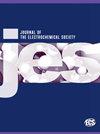Flexible Ni-Foam-Based Electrode with Novel MoS2/NiO Nanocomposite for Superior Supercapacitor Applications
IF 3.3
4区 工程技术
Q2 ELECTROCHEMISTRY
引用次数: 0
Abstract
In the present work, a simple and effective hydrothermal method has been used to synthesize a nanocomposite of nickel oxide and molybdenum disulphide. Structural and optical characterizations of the as-synthesised MoS2/NiO nanocomposite nanoparticles were carried out using X-ray diffraction (XRD) and UV-visible spectroscopy techniques. The major peaks of MoS2 and NiO were detected in XRD, confirming the formation of a composite. The reduced band gap of 2.84 eV of MoS2/NiO nanocomposite, as compared to pure NiO with a 3.1 eV bandgap, indicates a blue shift. The surface morphology of MoS2/NiO nanocomposite was measured using field-emission scanning electron microscopy, showing a sheet-like structure with fine particles overlaid on them. Cyclic voltammetry and electrochemical impedance spectroscopy (EIS) were used to determine the processes of charge transfer between electrodes, diffusion of molecules and ions within the electrolyte solution, and ion adsorption on the surface of the the electrode. The as-prepared composite shows an enhanced specific capacitance of 246 F g−1 at20 mV sec−1, a scan rate of which was more than both base materials in pristine form. EIS results thus obtained may give a new direction for supercapacitor applications with the as-synthesized sample.采用新型 MoS2/NiO 纳米复合材料的柔性镍泡沫电极可实现超级电容器的卓越应用
本研究采用简单有效的水热法合成了氧化镍和二硫化钼的纳米复合材料。利用 X 射线衍射 (XRD) 和紫外可见光谱技术对合成的 MoS2/NiO 纳米复合纳米粒子进行了结构和光学表征。在 XRD 中检测到了 MoS2 和 NiO 的主要峰值,证实了复合材料的形成。与带隙为 3.1 eV 的纯 NiO 相比,MoS2/NiO 纳米复合材料的带隙减小到 2.84 eV,表明发生了蓝移。使用场发射扫描电子显微镜测量了 MoS2/NiO 纳米复合材料的表面形貌,结果表明其呈片状结构,上面叠加有细小颗粒。循环伏安法和电化学阻抗谱(EIS)用于确定电极间的电荷转移、电解质溶液中分子和离子的扩散以及电极表面的离子吸附过程。制备的复合材料在 20 mV sec-1 时的比电容为 246 F g-1,扫描速率高于两种原始形式的基底材料。由此获得的 EIS 结果可能会为合成样品的超级电容器应用提供一个新的方向。
本文章由计算机程序翻译,如有差异,请以英文原文为准。
求助全文
约1分钟内获得全文
求助全文
来源期刊
CiteScore
7.20
自引率
12.80%
发文量
1369
审稿时长
1.5 months
期刊介绍:
The Journal of The Electrochemical Society (JES) is the leader in the field of solid-state and electrochemical science and technology. This peer-reviewed journal publishes an average of 450 pages of 70 articles each month. Articles are posted online, with a monthly paper edition following electronic publication. The ECS membership benefits package includes access to the electronic edition of this journal.

 求助内容:
求助内容: 应助结果提醒方式:
应助结果提醒方式:


